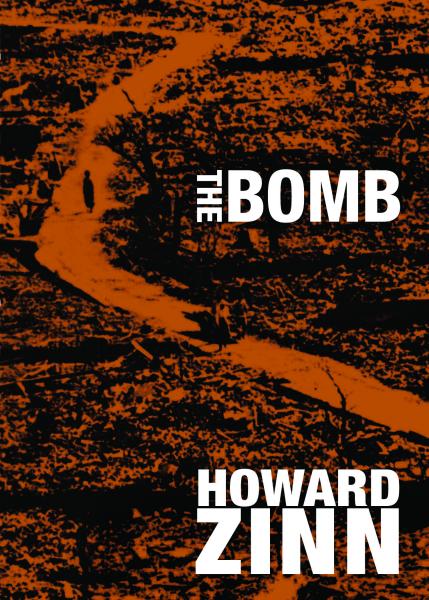“Flashes of Light”: Howard Zinn’s Last Call for Peace

The Bomb
By Howard Zinn
City Lights Publishers, 2010, 91 pages, $8.95
Bombing from the air makes war seem easy, effective, and bloodless—at least to those of us far from the ground zeroes. “To this day,” Howard Zinn writes, “the victims’ realities of aerial bombings [are] lost to most people in the United States, a military operation devoid of human feeling, a news event, a statistic, a fact to be taken quickly and forgotten.” Published eight months after the author’s death, The Bomb reminds us of the gaping hole left by the passing of this historian-activist.
The Bomb is divided into two parts. The first essay in the book, entitled “Hiroshima: Breaking the Silence,” could be read aloud on street corners and in houses of worship and education each year on August 6 in commemoration of the U.S. atomic bombing of that city and of Nagasaki two days later. In it, Zinn reviews the terror and destruction wrought by Little Boy (the name given to the bomb) on the harbor city of Hiroshima. In simple and compelling prose, Zinn picks apart the complex web of U.S. justifications for the use of nuclear weapons—ended the war, saved lives, etc.—until they unravel into so many feeble and cruel rationalizations for brute force and brutal geopolitical gamesmanship.
“The Bombing of Royan,” the second essay, is part investigation into aerial bombardment and part confession. Howard Zinn was not always the world-famous author of A People’s History of the United States. As a young man, he was a soldier in World War II. In fact, he was a bombardier, participating in aerial bombardment. In the introduction, he describes the surreal detachment of killing from thousands of feet above the French countryside: “…for people like me, a bombardier sitting in the Plexiglas nose of a B-17, operating my bombsight, observing flashes of light as the bombs hit, but seeing no human beings, hearing no screams, seeing no blood, totally unaware that down below there might be children dying, rendered blind, with arms and legs severed.”
Napalm
This section of this slim volume is the most compelling. He writes that in mid-April of 1945—just weeks before the end of the war in Europe—he set off on another bombing mission. “We were awakened in the early hours of the morning, went to the briefing where we were told our job was to bomb pockets of German troops remaining in and around Royan.” In the bellies of their bomber were 30 100-pound bombs full of “jellied gasoline”—napalm, being used for the first time. They went off into the early morning air. Zinn writes that when the bombs dropped, “I remember distinctly seeing, from our great height, the bombs explode in the town, flaring like matches struck in fog. I was completely unaware of the human chaos below.”
It took three more days of similar bombardments for the Germans entrenched in this area of France to surrender. By that point, an unknown number of civilians in Royan and the surrounding areas had been killed.
Zinn writes that this cavalcade of bombs was preceded by a rash of bombing in January that had succeeded in leveling the city of 20,000, which had been a popular vacation spot before the war. In the rest of the essay, Zinn explores the question of accountability. Who is responsible for the deaths of civilians in war? The generals who oversee the war? The war planners who pick the targets? The engineers who design the bombs? The pilots who fly the bombers? The bombardiers who help drop the bombs? The “enemy” occupiers who infiltrate civilian population centers? “Everyone can point, rightly, to someone else as being responsible,” Zinn writes. “The mass production of massive evil requires an enormously complicated division of labor.”
The United States is once again employing aerial bombardment and, in fact, has taken it one step further by removing the conscience in the cockpit and using unmanned drones. This new development in warfare—which is being employed with devastating consequences in Pakistan, Afghanistan, and elsewhere—means that the violence is even more remote. It also means that there is no witness—not even thousands of feet above the epicenter—who can be haunted and moved by what he or she sees, who can go back years later and ask why, and let the answer to that question direct his or her life to activism, nonviolence, and a tireless pursuit of accountability.
The path that Howard Zinn walked—from bombardier to activist—gives hope that each of us can move from clinical detachment to ardent commitment, from violence to nonviolence.
